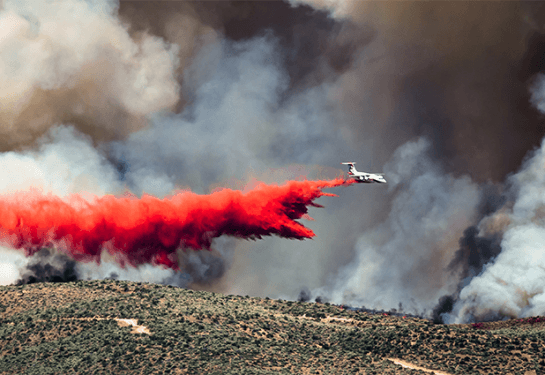Wildfire preparation tips for protecting businesses
Extreme weather events such as hurricanes, tornadoes, hailstorms and wildfires continue to make headlines as they become increasingly devastating and costly. Making matters worse, these events aren’t limited to one geographic area or weather event, impacting businesses and residents across the United States.
 Since 1980, the United States has been affected by 285 weather and climate disasters. The total cost of these 285 events exceeds $1.875 trillion.1 In 2020, the United States experienced 22 weather-related disasters that had losses exceeding $1 billion each. This included one drought, 13 severe storms, seven tropical cyclones and one wildfire.2 With these events, the United States has experienced 10 or more billion-dollar weather-related disasters each year for six consecutive years.
Since 1980, the United States has been affected by 285 weather and climate disasters. The total cost of these 285 events exceeds $1.875 trillion.1 In 2020, the United States experienced 22 weather-related disasters that had losses exceeding $1 billion each. This included one drought, 13 severe storms, seven tropical cyclones and one wildfire.2 With these events, the United States has experienced 10 or more billion-dollar weather-related disasters each year for six consecutive years.
While every natural disaster has the potential to irreversibly damage a business’s property, wildfires are especially threatening. In fact, one wildfire has the potential to devastate an entire community, underscoring the importance of proactive risk management. This article provides an overview of wildfires and steps that organizations can take to protect their property.
The dangers of wildfires
Wildfires are common throughout the United States. From 2011 through 2020, there was an average of about 63,000 wildfires each year, affecting 7.5 million acres of land annually.3 These fires are especially dangerous for property owners, as just one fire can spread quickly and level an entire business.
Approximately 4.5 million U.S. homes are at high or extreme risk of wildfire. In fact, the top 10 states with a high or extreme wildfire risk are California, Texas, Colorado, Arizona, Idaho, Washington, Oklahoma, Oregon, Montana and Utah. Behind California, interestingly, Texas, North Carolina, Georgia, Oregon and Florida experienced the highest number of wildfires in 2019.4 These fires can be incredibly damaging. Wildfires burned nearly 700,000 acres of land in Colorado during 2020. One of the fires was the largest in the state’s history.5
Nearly 85% of wildfires in the United States are caused by humans.6 Often, these fires are the result of unattended campfires, the burning of debris, equipment use and malfunctions, negligently discarded cigarettes and intentional acts of arson. The remaining wildfires are typically caused by lightning or other weather events.
Regardless of the cause, wildfires can spread to communities and force people to evacuate their businesses and homes. While firefighters will do all they can to prevent the spread of a wildfire, their limited manpower and resources may prevent them from defending a business’s property. While wildfires — like all natural disasters — are unpredictable, businesses can take measures to reduce the risk of their property being lost to one.
Specifically, in the case of wildfires, proactive risk management is crucial and can involve creating a defensible space around the property, utilizing fire-resistant materials in building construction and having a wildfire plan in place.
Tip 1. Create a defensible space around the property
Wildfires rely on heat and embers moving between fuel sources to spread. Accordingly, one of the most effective ways to prevent the spread of a wildfire to a property is to provide less fuel for the fire. Businesses can accomplish this by creating cleared zones around their property. This involves moving or removing vegetation and other sources of fuel in a way that makes it difficult for a fire to spread and reach the business.
The specific spacing needed between landscaping and a building can differ depending on the type and size of the shrubbery as well as the slope of the land. However, there are some best practices to consider, including creating three distinct buffer zones around the property as detailed by the Insurance Institute for Business & Home Safety:
-
- Zone 1 (0-5 feet from the building) The area immediately surrounding a property — 5 feet in any direction from the building — should be cleared of anything combustible that a wildfire could use as fuel. Flammable species of plants such as pine, spruce and juniper trees should not be present in this zone at all. If a business is unsure about the flammability of various plants, it should contact its local fire department for more information.7 In addition to vegetation, it’s important to keep this area clear of other objects that might easily catch fire. Property owners should regularly clear sticks, leaves and other debris that might collect around the building. Use hardscaping (gravel, rock, concrete) in this area to keep it as noncombustible as possible.
- Zone 2 (5-30 feet from the building) — Slowing or stopping the spread of fire in areas between 5 and 30 feet of a property can greatly reduce the chances of a fire spreading. In this zone, fire can spread easily between trees. Accordingly, it’s important to prune trees and clean up fallen branches, leaves and needles. Where possible, businesses should space trees in this zone at least 10 feet apart, measured by the outermost branches of each tree, and prune all tree branches that are within 8 feet of the ground.8 This helps prevent fire from spreading from tree to tree, as well as ground fire from moving into the treetops. To reduce the “ladder effect,” shrubs should not be planted under trees without proper spacing and clearance.
- Zone 3 (30-100 feet or more from the building) — In Zone 3, the goal is to create an environment in which fires will be less intense. To do this, businesses should continue to prune trees the same way they treat Zone 2 trees. Consider both the vertical and horizontal spacing of the vegetation. This makes it difficult for fires to jump between trees and other vegetation. It’s also important to clear dead trees in Zone 3, especially if they could pose a threat to power lines or fire access roads.9
To ensure that they are doing everything in their power to protect their property from wildfires, businesses should work with experienced and qualified insurance professionals. Additionally, every property is different and has its own set of unique risks. As such, it’s critical for businesses to have a thorough inspection done to better understand the risks specific to their property. Inspections, when completed by a certified professional, can provide valuable insight into a property’s ability to withstand a wildfire.
Using fire-resistant materials where possible can help a property better withstand a wildfire. In terms of available fire-resistant materials, there are a number of options, including fire-rated glass, concrete, fire bricks, fire-retardant wood and fire-rated doors, among others.1 The material chosen may differ depending on what’s been constructed. For example, when constructing a roof, businesses may consider installing noncombustible roof coverings made of materials like clay and concrete tile, slate, fiber cement, and metal shingles and panels. Aluminum, steel or copper gutters can also provide some resistance to fires.
When building or renovating a property, it’s important to work with qualified contractors. That way, you are choosing the best materials to protect your property from wildfires and similar hazards.
Tip 2. Have a business emergency plan in place
Preplanning can make all the difference when it comes to protecting a property from a wildfire. In fact, businesses that already have a disaster plan in place typically recover more quickly from a wildfire than those that don’t have one. Furthermore, if a business has no disaster recovery plan in place, there’s a good chance that the organization may never recover fully from a wildfire.
While the specifics of this plan will differ from business to business, it should account for having a fire evacuation plan for businesses, and actions to take before, during and after a wildfire. Specific actions can include, but are not limited to, the following:10 11 12 13
| Before a wildfire | During a wildfire | After a wildfire |
|
|
|
Tip 3. Include wildfire preparation as part of a business continuity plan
A business’s wildfire plan should be part of a larger business continuity plan. If implemented and maintained correctly, that larger continuity plan can be the difference between successfully recovering from a business interruption (such as a wildfire) and sustaining significant financial damage. Business continuity planning will aid the business in identifying the impact of potential losses, maintaining viable recovery strategies and ensuring the continuity of operations during a crisis.
Effective business continuity planning is all about taking an all-hazards approach. What this means is that businesses have some plan in place to mitigate the impact of risks that could affect their operations. It’s not about planning for if a wildfire impacts the business, but when. This process can involve performing a business impact analysis to determine what the organization’s key priorities are and what aspects of the operation should be prioritized in the event of a disaster. This gives organizations clear direction following an adverse event, ensuring that the most vital aspects of their business — whether it be a specific building, application or vendor — are considered.
It’s important for businesses to remember that, in the event of a wildfire, hundreds or even thousands of structures can be affected. This means that other businesses and residents will be seeking help from contractors at the same time, and — for those without pre-established relationships or agreements with contractors — the waiting period to restore a property could be lengthy. To reduce the impact on their bottom line, businesses need to have a continuity plan in place that will reduce downtime and manage costs.
Businesses aren’t alone when it comes to crafting a disaster or business continuity plan. To ensure that they’re taking all of their risks and unique needs into account, it’s crucial for them to partner with the right insurance professionals — professionals with the expertise necessary to provide tailored guidance.
Sources
-
1
https://www.ncdc.noaa.gov/billions/
-
4
https://www.iii.org/fact-statistic/facts-statistics-wildfires
-
5
https://disasterphilanthropy.org/disaster/2020-california-wildfires/
-
6
https://www.nps.gov/articles/wildfire-causes-and-evaluation.htm
-
7
https://www.fs.usda.gov/nac/buffers/guidelines/5_protection/11.html
-
8
https://www.fs.usda.gov/nac/buffers/guidelines/5_protection/11.html
-
9
https://nasdonline.org/1105/d000896/creating-fire-safe-zones-around-your-forested-homesite.html
-
11
https://danecontractors.com/our-blog/2017/10/10/fire-prevention-for-commercial-properties
-
12
https://blog.nationwide.com/wildfire-preparedness-guide/




